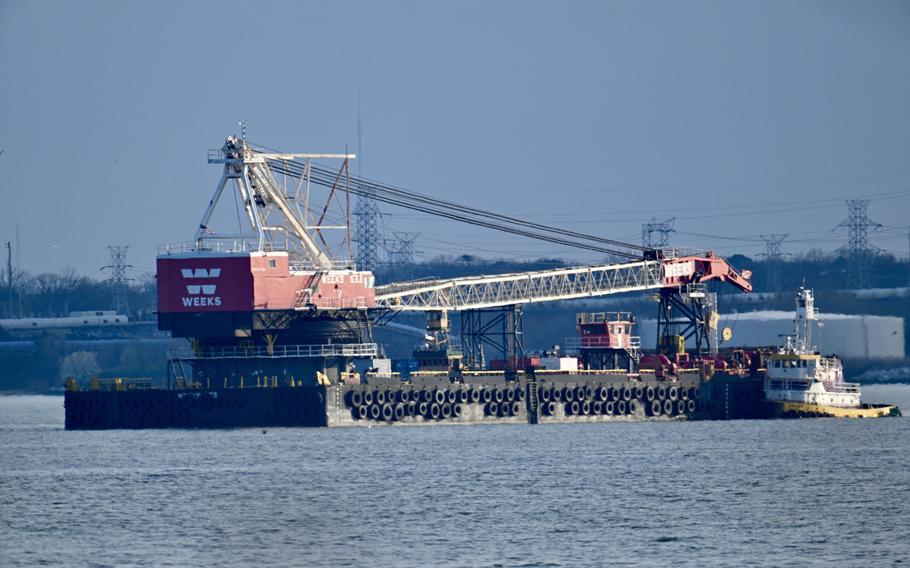
The Weeks 533 crane barge arrives at TradePoint Atlantic to assist with the salvage of the Francis Scott Key Bridge on March 31, 2024. (Jerry Jackson, Baltimore Sun/TNS)
BALTIMORE (Tribune News Service) — Less than a week after the Francis Scott Key Bridge collapsed into the Patapsco River after being struck by a cargo ship, a 200-ton chunk of the span was lifted away as part of the cleanup operation. That first crane operation on Saturday, which Gov. Wes Moore said took 10 hours in total, was a “relatively small lift.”
“We’re talking about something that is almost the size of the Statue of Liberty,” Moore said in a Monday news conference. “The scale of this project, to be clear — it is enormous. And even the small lifts are huge.”
The recovery effort has brought to Baltimore multiple massive cranes — with storied pasts.
Late Thursday night, the Chesapeake 1000 crane barge arrived at the site of the Key Bridge collapse, according to the Joint Information Center of the Unified Command. It was joined by two others contracted through Naval Sea Systems Command, all to be put to use removing “submerged portions of the Francis Scott Key Bridge,” according to a Navy news release.
As of Tuesday evening, nine cranes were on site with four more scheduled to arrive to assist with the Key Bridge collapse response, a Joint Information Center spokesperson said.
The Chesapeake 1000, dating back to the early 1970s and now owned by Donjon Marine Co., is named for its ability to lift 1,000 tons with a boom over 230 feet long. Originally, it was called the Sun 800, notable for playing a role in a CIA mission called “Project Azorian,” said Gene Schorsch, who oversaw the creation of the Sun 800 at Sun Shipbuilding & Drydock Co., where he held many titles over the years.
The Sun 800, at the time the “largest capacity … barge crane on the East Coast,” according to a declassified CIA article, was created to work on the Hughes Glomar Explorer. That ship was “ostensibly built and owned by billionaire Howard Hughes,” according to the CIA, but was actually tasked during the Cold War with recovering a wrecked Soviet submarine in the Pacific Ocean.
The crane has been upgraded and received repairs, and has been used in multiple other recovery efforts.
“It’s absolutely appropriate” that the Chesapeake 1000 is at the site of the Key Bridge collapse now, said Schorsch, 95.
The Chesapeake 1000 has not yet been used at the site of the Key Bridge collapse, but is being kept “on standby for when we need to go to larger lifts,” said U.S. Navy Capt. Sal Suarez, the supervisor of salvage operations, during a news conference Tuesday afternoon.
The same goes for another noteworthy crane, Weeks 533, which was seen arriving to TradePoint Atlantic on Sunday. The barge-mounted crane is fully revolving and touted as the “largest of its kind on the East Coast.”
In 2009, the 500-ton capacity crane lifted the downed U.S. Airways Flight 1549 from the Hudson River in New York. A few years later, also in New York, it gave the Enterprise space shuttle a ride onto the USS Intrepid, a retired aircraft carrier-turned-museum. It’s also carried the Concorde, a supersonic jet, on more than one occasion, including just last year.
The “Big Bitch,” as Wired reported Weeks 533 has been called, teamed up with Chesapeake 1000 in 2003, for work on the capsized Stellamare cargo ship at the Port of Albany. Now, they’re both poised to see action yet again in Baltimore.
Baltimore Sun reporter Dan Belson contributed to this article.
©2024 The Baltimore Sun.
Visit baltimoresun.com.
Distributed by Tribune Content Agency, LLC.